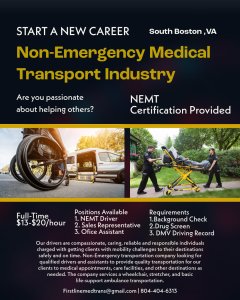
This event has passed.
HIRING EVENT: First Line Transport
July 12, 2023 @ 10:00 am - 2:00 pm

Join us July 12. 2023 for this HIRING EVENT for First Line Transport. It will run from 10-2pm here at the center and representatives will be onsite to answer your questions!

Here is a little more information for those interested…
Non-Emergency Medical Transportation Drivers Job Description
- Leverage standard maps or the GPS to find short and safe routes to destinations. ● Drive assigned vehicles along predetermined routes, and guarantee the safety and well-being of all onboard.
- Carry out pre-trip inspections on assigned vehicles to validate that they are in good working order.
- Make vehicles ready for transport by ensuring that patients’ sitting and lying down areas are cleared.
- Help medical staff members ensure patients get on board the van or transit, and also verify that they are properly strapped in.
- Take instructions from dispatch teams concerning destinations and timelines, and make sure both are taken into account when making deliveries of transports.
- Help members of the medical staff in unloading patients, samples, and documents in a safe manner.
- Always give updates to dispatch units in terms of the status of deliveries and transports. ● Verify that assigned vehicles are properly parked in their assigned areas/spots at the end of the shift.
- Carry out both preventative and regular maintenance on assigned vans. ● Provide supervisors with information on any issues or problems that may surface during regular vehicle checkups.
- Education and Qualifications for Medical Transportation Drivers
- Although every state has specific qualifications for medical transportation drivers, here are the most common education and experience requirements for medical transportation drivers in the United States.
Requirements:
- Drivers are expected to hold a currently valid driver’s license.
Physical Requirements:
- Ability to lift, push, pull, and position patients. Should be able to lift up to 100 lbs. without assistance.
- Exposure to a wide range of weather conditions.
- Ability to carry out considerable reaching, stooping, and bending.
- Hearing and vision abilities should be within the normal range to drive safely and to observe and communicate with patients.

